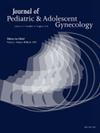病理证实的青春期子宫内膜异位症患者的特点和术前处理:一项多机构研究。
IF 1.8
4区 医学
Q3 OBSTETRICS & GYNECOLOGY
引用次数: 0
摘要
研究目的:这项多机构、观察性、回顾性队列研究旨在描述病理证实的子宫内膜异位症患者的人口统计学特征和术前医疗管理。结果:在305例患者中,首次就诊于儿科和青少年妇科(PAG)的中位年龄为15.6岁(四分位数范围:14.2-17.1)。大多数患者为白人(83.3%),大多数患者有商业保险(70.5%)。只有4.3%的人在首次出现PAG之前被诊断为子宫内膜异位症。常见症状包括进行性痛经(76.7%)、月经大量出血(50.8%)、痛经导致缺课(55.1%)。除PAG外,患者还向一系列提供者寻求治疗其症状,包括初级保健/青少年医学(75.1%)、胃肠病学(18.7%)、成人妇科(22.3%)和物理治疗(13.4%)。几乎所有患者(92.8%)在腹腔镜检查前尝试口服激素抑制月经。激素管理包括联合口服避孕药(62.3%)、醋酸甲羟孕酮注射液(15.7%)、每日诺瑞丁酮≤5mg(14.8%)、每日诺瑞丁酮bbb50 mg(13.4%)、激素宫内系统(13.1%)和植入避孕剂(5.3%)。结论:病理证实的子宫内膜异位症患者通常表现为进行性痛经、缺课或活动、大量月经出血。他们从各种提供者那里寻求治疗,虽然大多数人尝试用激素治疗症状,但使用的方法各不相同。本文章由计算机程序翻译,如有差异,请以英文原文为准。
Characteristics and Preoperative Management of Adolescent Patients with Pathology-Confirmed Endometriosis: A Multi-Institutional Study
Study Objective
This multi-institutional, observational, retrospective cohort study aimed to characterize the demographics and preoperative medical management of patients with pathology-confirmed endometriosis.
Methods
We reviewed patients <22 years at 8 tertiary care pediatric hospitals in the Midwestern United States who underwent diagnostic laparoscopy and had biopsy-confirmed endometriosis. Patients were identified through pathology records. Demographics, medical history, clinical symptoms, and prior medical management were extracted. Descriptive statistics were computed.
Results
Among 305 patients, median age at first presentation to pediatric and adolescent gynecology (PAG) was 15.6 years (interquartile range: 14.2-17.1). Most patients were White (83.3%) and most had commercial insurance (70.5%). Only 4.3% had a diagnosis of endometriosis prior to their initial presentation to PAG. Common symptoms included progressive dysmenorrhea (76.7%), heavy menstrual bleeding (50.8%), missed school/activities due to dysmenorrhea (55.1%). Patients sought care for their symptoms from a range of providers in addition to PAG, including primary care/adolescent medicine (75.1%), gastroenterology (18.7%), adult gynecology (22.3%), and physical therapy (13.4%). Nearly all patients (92.8%) tried oral hormonal menstrual suppression prior to laparoscopy. Hormonal management included combined oral contraception (62.3%), medroxyprogesterone acetate injection (15.7%), ≤5mg daily norethindrone (14.8%), >5mg daily norethindrone (13.4%), hormonal intrauterine system (13.1%), and contraceptive implant (5.3%).
Conclusions
Patients with pathology-proven endometriosis typically presented with progressive dysmenorrhea, missed school or activities, and heavy menstrual bleeding. They sought care from a variety of providers and while most tried hormonal management of symptoms, the method used varied.
求助全文
通过发布文献求助,成功后即可免费获取论文全文。
去求助
来源期刊
CiteScore
3.90
自引率
11.10%
发文量
251
审稿时长
57 days
期刊介绍:
Journal of Pediatric and Adolescent Gynecology includes all aspects of clinical and basic science research in pediatric and adolescent gynecology. The Journal draws on expertise from a variety of disciplines including pediatrics, obstetrics and gynecology, reproduction and gynecology, reproductive and pediatric endocrinology, genetics, and molecular biology.
The Journal of Pediatric and Adolescent Gynecology features original studies, review articles, book and literature reviews, letters to the editor, and communications in brief. It is an essential resource for the libraries of OB/GYN specialists, as well as pediatricians and primary care physicians.

 求助内容:
求助内容: 应助结果提醒方式:
应助结果提醒方式:


